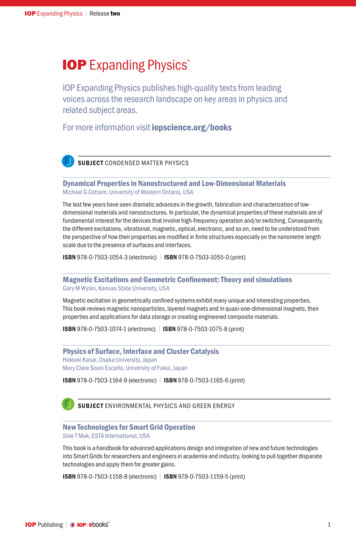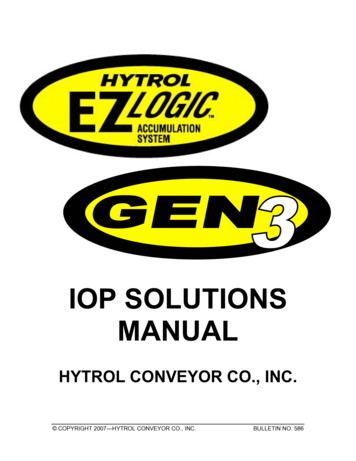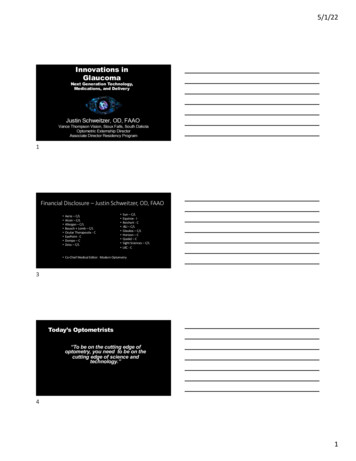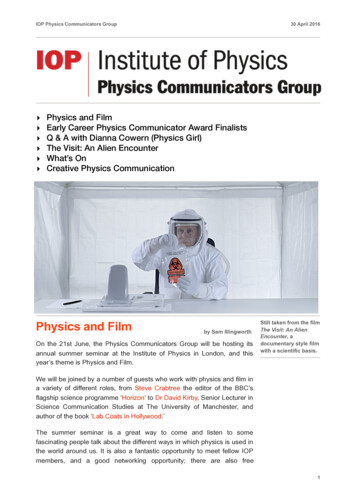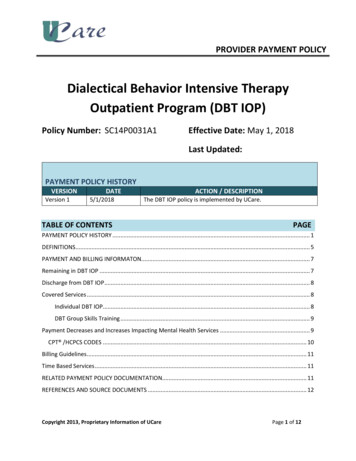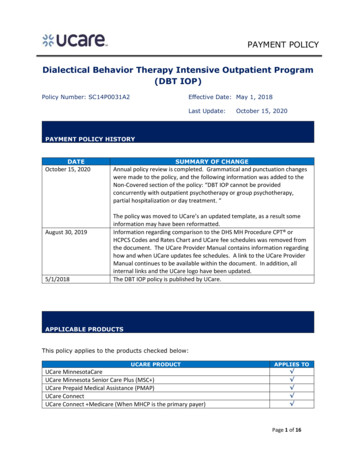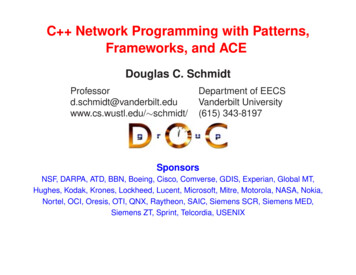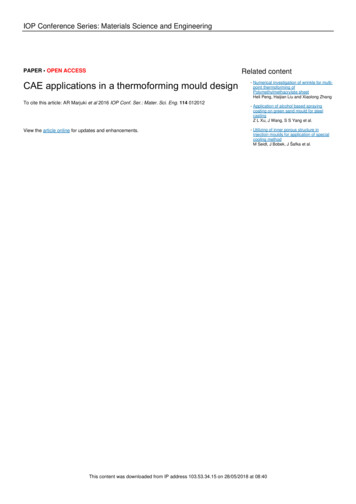
Transcription
IOP Conference Series: Materials Science and EngineeringRelated contentPAPER OPEN ACCESSCAE applications in a thermoforming mould designTo cite this article: AR Marjuki et al 2016 IOP Conf. Ser.: Mater. Sci. Eng. 114 012012View the article online for updates and enhancements.- Numerical investigation of wrinkle for multipoint thermoforming ofPolymethylmethacrylate sheetHeli Peng, Haijian Liu and Xiaolong Zhang- Application of alcohol based sprayingcoating on green sand mould for steelcastingZ L Xu, J Wang, S S Yang et al.- Utilizing of inner porous structure ininjection moulds for application of specialcooling methodM Seidl, J Bobek, J Šafka et al.This content was downloaded from IP address 103.53.34.15 on 28/05/2018 at 08:40
iMEC-APCOMS 2015IOP PublishingIOP Conf. Series: Materials Science and Engineering 114 (2016) 012012 doi:10.1088/1757-899X/114/1/012012CAE applications in a thermoforming mould designAR Marjuki1 , FA Mohd Ghazali1 , N M Ismail1 , S Sulaiman1 , I MohdKhairuddin1 , Anwar P P A1 Majeed, AA Jaafar1 , F Mustapha2 andS Basri11Fac of Manufacturing Eng, Universiti Malaysia Pahang, 26600, Pekan Pahang, MalaysiaDept of Aerospace Eng, Fac of Eng, Universiti Putra Malaysia, Serdang 43400, Selangor,Malaysia2E-mail: ensaaj@ump.edu.myAbstract. Preparation of honeycomb layer is a critical step for successful fabrications ofthermoformed based sandwiched structures. This paper deals with an initial investigationon the rapid manufacturing process of corrugated sheet with 120o dihedral angles. Timehistory of local displacements and thickness, assuming viscous dominated material model for a1mm thick thermoformable material, was computed by using ANSYS R Polyflow solver. Thequality of formed surfaces was evaluated for selection of mould geometry and assessment oftwo common variants of thermoforming process. Inadequate mesh refinement of a membraneelements produces satisfactorily detailing and incomplete forming. A perfectly uniform materialdistribution was predicted using drape forming process. However, the geometrical propertiesof vacuum formed part are poorly distributed and difficult to control with increasing inflationvolumes. Details of the discrepancies and the contributions of the CAE tool to complementtraditional trial and error methodology in the process and design development are discussed.1. IntroductionIn modern thermoforming manufacturing practices, prototype evaluation activity is an importantstep in the design process. Effective assessment may require complete understanding on thedetails of the manufacturing process. Following Throne (2008), the drape and vacuum formingprocesses begin by positioning a mould over a platen. A thermoformable blank material isclamped to a holding frame and heated up to a forming temperature. The transfer stage is wherethe heated blank material is brought into contact with the platen at a designated approachingspeed. The forming stage is immediately initiated by evacuating the air between the mouldand the blank material for forming processes. Cooling stage is where the formed part is leftcooled to retain the final shape and then it is removed from mould as part of the removalstage. Computer Aided Engineering (CAE) are extensively applied to optimize these stages tofulfill many demanding objective and cost functions. Computer simulations may also be used toexamine product robustness with the availability of new material and technology. During the lastfew decades CAE has been a valuable tool to the thermoforming industries. A variety of productshave been produced to reach wider industrial needs. Integration of advanced numerical methods,traditional trial and error approaches and the downstream predictive technologies such as processoptimization and machine learning method have made further improvement on the productdevelopment. To date detail implementation of finite element analysis (FEA) for thermoformingthin gauge thermoformable material is continuously reported in the open literatures. A genericContent from this work may be used under the terms of the Creative Commons Attribution 3.0 licence. Any further distributionof this work must maintain attribution to the author(s) and the title of the work, journal citation and DOI.Published under licence by IOP Publishing Ltd1
iMEC-APCOMS 2015IOP PublishingIOP Conf. Series: Materials Science and Engineering 114 (2016) 012012 doi:10.1088/1757-899X/114/1/012012material were also studied for various reasons. Kershner and Glacomin (2007) for exampledetermined Lagrangian properties by solving the continuity and momentum equations thatgovern the constrained inflation of a Newtonian fluid over a truncated cone surfaces of a negativemould. The near melt states were assumed for the thermo-mechanical properties. Total forming,forming and contrained forming times and intervals were approximated by using a thin filmapproximations. It was shown that the blank material gradually evolves from flat to eitherlenticular or bulbous shapes according to the cone angle. The analytical solutions proved that thedetailing or thermoform sharp edges and corners are practically difficult to achieved. Peplińskiand Mozer (2011) modeled a 1mm thick blank material as a fluid membrane as the thicknesswas two order of magnitude lower than the other dimension. ANSYS R Polyflow solver was usedto simulate vacuum forming process of a rotationally symmetric cup. The near melt density anddynamic viscosity of the blank material were set to 900 kg/m3 and 8630 Pa.s respectively. Theapproaching speed during transfer stage was 50 mm/s and the inflation phase was maintainedat 500kPa forming pressure. The blank material was meshed with 3-nodes triangular membraneelement and the part quality was determined by a minimum wall thickness of 0.3mm. Withthe advances in constitutive modeling, various material models were proposed to improve thepredictions of the nonlinear deformation behavior of thin gauge thermoplastics materials duringthe inflation phase. Karamanao et al(2006) approximated the behavior of a generic thin gaugethermoformable material as a finite viscoelastic material. Constitutive modeling using a finitedeformation generalization of a spring and dashpot material model relates the internal stressstate with the entire history of material deformation. Computer simulations were carriedout using a high temperature incompressible membrane element that can sustain no bendingmoments. Detailing predictions were reported with a residual based error estimator for meshrefinement strategy. The algorithm was used to adaptively identify large deformable membraneelement and those in the proximity of complex contact surfaces. Good surface replication whenmultiple plane point transition corners are refined with adequate density of computational mesh.Dong et al (2006) models the acrylic as a hyperelastic Mooney-Rivlin and Ogden material withpath-independent characteristics. A dynamic explicit theory incorporated in a commercial codePAM-FORM R were selected with an automatic selective adaptive and uniform remeshing meshrefinement algorithms.The blank material was meshed with 4-node quadrilateral thin flat shellelements which capable of out of plane deformation. A prescribed angle between elements totrigger complex surface contour was used as the criteria for automatic selective adaptive gridrefinement. A uniform mesh refinement algorithm was also applied in a defined adaptive regiondomain. Using typical industrial process conditions Ó Connor et al (2013) simulated the behaviorof a 1.23mm thick polypropelene during the forming phase using a 3-node thick axisymmetricthermo-mechanically coupled shell elements that allow in-plane deformation and temperaturegradient. A constitutive equation for a large deformation thermally coupled viscoelastic materialmodel was proposed to allow heat loss during the forming processes. A multiphysics strategyin simuli ABACUS/Standard was adopted to determine the total pressurised phase by usinga computational fluid dynamic approach. A plug-assisted vacuum forming was simulated forrotationally symmetric receptacle. An adaptive mesh algorithm was applied to modify themesh density at location where considerable material straining and rapid changes of surfacegeometry. Realistic contact force and material distribution was achieve with adequate numberof contact element to resolve the mould surface curvature. Lupea and Cormier(2007) assumedthat the behavior of an energy absorbing material SafetyPlastic R can be represented by anelasto-plastic material. A drape forming process of a truncated cone was simulated using acommercial nonlinear finite element solver LS Dyna and R with a 4-node quadrilateral MAT19,MAT24 and MAT81 shell elements. Denser mesh was located in the circumferential direction.Kittikanjanaru and Patcharaphun (2013) examined a 1mm thick HIPS and A-PET with densityof 1040 and 1370 kg/m3 respectively. Both materials were assumed to behave as a visco elastic2
iMEC-APCOMS 2015IOP PublishingIOP Conf. Series: Materials Science and Engineering 114 (2016) 012012 doi:10.1088/1757-899X/114/1/012012K-BKZ non-linear and time-independent material during a drape and vacuum forming of atruncated cone and a food tray. The computations were carried out using a nonlinear finiteelement solver T-SIM R with 3-node triangular shell elements. The study assessed the formingprocess from the predicted material distribution. Chevaugeon et al (2000) studied a fibersreinforced thermoplastic behavior during drape forming process of circular mould. The behaviorof the blank material was represented by a hyperelastic traversely isotropic material and thesimulation was made by using 3-node isoparametrical triangular flat membrane elements thatdeform in out-of plane direction. An automatic remeshing algorithm of the nonlinear finiteelement solver T-SIM R allocated denser mesh in high curvature region at the adiabatic and rigidcontact surfaces. Thicker part was predicted at the flange of the formed part and thinner at themould edges. Erchiqui et al (2005) treated a 1.6mm thick ABS as an isotropic incompressiblethermoplastic material. The viscoelastic integral of Lodge and Christensen material models, andthe hyperelastic Mooney-Rivlin and Ogden material model were assessed for large deformationwith finite strain and plane stresses. With 1.0s blow time, drape forming process was simulatedusing a specific purpose built dynamic explicit finite element solver Thermoform that capableto resolve exponentially rapid changes in the solution components. The blank material wasmeshed with 3-node isothermal isoparametric plate elements. Peng et al (2012) treated a 2.75mmthick wood polypropelene composites thermoviscoelastic material and modeled the elastic andviscoelastic properties of wood and polymer respectively. Drape forming of car interior partwas simulated using explicit finite element solver LS Dyna with 3-node isoparametric plateelements. Thongwichean et al (2012) proposed a temperature dependence material model thatwas insensitive to strain rate and no strain hardening after yield. The model was configuredinto a finite element solver Simula Abaqus agree to simulate the behavior of a Tapioca starchbiodegradable polyester blend of Enpol R TM . The blank material was meshed with 2D shell (S8)element. The approaching speed of 2.5mm/s was assumed during the transfer stages to a rigidand adiabatic mould surfaces. These studies among others not considered here implementedvirtually the same numerical setup and engineering assumptions. This article is intended tocomplement these efforts by addressing aspects of mould design for thermoformed honeycombcore parts as shown in Figure 1. In industrial applications, the plastic products have been usedfor a variety of purposes such as sound and vibration damping and filtering medias. It is smallin size and is characterized by simple geometrical features. Vacuum and drape thermoformingprocesses were simulated and it is hypothesized that the quality of the formed part will bevaried with the changes in the mould design and selection of manufacturing process. Theobjective of the study is to conduct parametric assessment on material distribution during theforming stage of both manufacturing processes. Details engineering approach for mould designevaluation is described in the following sections. Relationship between the computed results andthe formulated hypothesis is the summarized and concluded.Table 1. Physical parameter specifications for corrugated honeycomb layer.Geometrical propertyspecificationDihedral angle 10 3 (o )Pitch 10 3 (mm)Node bonds 10 3 (mm)Ribbon, l 10 3 (mm)Cell size 10 3 (mm)thickness, w 10 3 (mm)12094.512071003
iMEC-APCOMS 2015IOP PublishingIOP Conf. Series: Materials Science and Engineering 114 (2016) 012012 doi:10.1088/1757-899X/114/1/012012Figure 2. Schematics of corrugated patternand perspective view of positive mould.Figure 1. Pictorial images of thermoformed(a) corrugated honeycomb layer and (b)honeycomb core .Figure 3. Design of vacuum forming process2. Computational Model and Numerical MethodsA honeycomb layer is designed to construct a hexagonal honeycomb core as shown in Figure 1.For convenience in describing the physical model, the layer is viewed as corrugated plate withregular and periodic pattern of flat planes. These planes intersect at 2-plane point transitioncorners and form 120o dihedral angle . The perspective view of a positive mould and theschematics of corrugated pattern are shown in Figure 2 and its specifications are summarizedin Table 1. As a basis for part quality evaluation, the engineering assumptions for the blankmaterial and mould are briefly given as follows: The thermo-mechanical properties of a generic thermoformable material are evaluated atnear-melt states and are assumed constant and isotropic. Rigid, adiabatic and smooth contact surfaces isothermal and rapid forming process aspect of mould design such as draft, vent hole, surface textures are not implemented.The mould will be positioned at the centroid of a platen and such arrangement introduced2- and 3-plane point transition corners and forming surfaces. The area of both platen and thepre-cut blank material are (Ai )140x160mm2 and the flat free surface(Ao ) of 100x120mm2 . Dueto symmetrical properties, the computational model is A4i ( 70 x80mm2 ). The initial thicknessof the blank material (hi ) is 1mm. The origin of the solution domain (x 0, y 0, z 0) islocated at a point where symmetry planes in x and y-directions intersect with z 0 plane.4
iMEC-APCOMS 2015IOP PublishingIOP Conf. Series: Materials Science and Engineering 114 (2016) 012012 doi:10.1088/1757-899X/114/1/012012Figure 3 shows the two consecutive stages of the forming processes. In the transfer phase,the blank material maintain an approaching speed of 30mm/s and is brought into contact withthe platen at constant deceleration when the separation distance between the surfaces is 5mm.The edges of the blank material and platen remain attached and the inflation phase beginimmediately by raising the air pressure. The total pressurised interval (θp ) to bring the pressureup to a forming pressure(pa ) takes 0.5s. It is kept constant at 138kPa throughout the inflationphase(θi ). Ideally the total manufacturing time (θT θi ) should be determined by the periodrequired by the blank material to capture the entire working surface of the mould. Howeverthis is not possible in the presence of multiple -plane transitions point transition corners. Inthis article, all computer simulations were terminated when a prescribed number of time stepis reached. The equations that governed the forming process of the blank material during thesestages are derived from the Lagrangian motion of an infinitesimally small control mass in thematerial are given below: · v 0(1) p · T f ρa(2)where p, T , f , ρ, a and v are the Lagrangian forms of pressure, extra-stress tensor ,bodyforce, density of 1000 kg/m3 , acceleration and velocity respectively. The continuity equationsimply provide an insight that any local thinning is accompanied by a plane deformation. Thisis consistent by assuming that the second viscosity does not responsible to the volumetricdeformation. In this article, the behavior of the blank material is represented by the GeneralizedNewtonian fluid material model such that T is defined asT 2ηD(3)where η is the zero shear rate viscosity and take the value of 105 Pa.s. In the absence of contact,the kinematic conditions is given by xi(4) twhen the contact is established between two different surfaces, deformable-to-rigid contact isassumed whereby the local reaction force is modeled by a penalty method algorithm. Theparallel and normal components of the local surface force are respectively given byvi fs Cs [v(s, t) Vm (s, t)](5)fn Cn [v(n, t) Vm (n, t)](6)where Ct and Cn are known as slipping and penalty coefficients respectively and took the valueof 1010 Ns/m. Details of the numerical implementation for solving the algebraic governingequations is given in the ANSYS R Polyflow online documentation[12] . In summary, the blankmaterial is divided into finite membrane elements, and the governing equations are discretisedusing a finite element method. The surface contact force is derived by meshing the mouldsurfaces with finite contact elements . At the beginning of computations, 5600 membraneand 11455 contact elements took a structured distribution of 4-node quadrilateral structuralelements. The ANSYS R Polyflow solver was configured to adopt an implicit Euler differencingscheme with typical minimum and maximum time steps of 1 10 5 s and 0.1s respectively.In order to satisfy the rigid surface assumption, the solver was fed with a hard constraint toautomatically terminate further iterative calculations on membrane deformation if the maximum5
iMEC-APCOMS 2015IOP PublishingIOP Conf. Series: Materials Science and Engineering 114 (2016) 012012 doi:10.1088/1757-899X/114/1/012012mould normal deformation of 0.05mm is reached. The transient computations were carried outon a personal computer with Intel R Core (TM) i5-2400 CPU @ 3.10GHz and 4.00 GB RAM.The Ansys R Polyflow solver is executed on 32-bit Windows 7 Professional operating system toprovide the time history of forming process up to 500 successful time step. Table 2 tabulatesthe test matrix for a range of mould height, H considered in the present study. Majority of thetest case took at most 5400 sec of CPU times to complete.Table 2. Test Matrix for numerical experiment: pa 138kPa, Vm (z,0) 30mm/s, hi 1mm,η 105 Pa.s, ρ 1000kg/m3 , generic thermoformable material at near-melt statesMould Height(H) 10 3 (m)negative mouldpositive mould-50 -40 -30 -20 -100 10 20 30 40 503. Results and DiscussionThis section addresses a part quality in the context of numerical result. Two main concernsare the detailing and material distribution. Acceptable predictions of material behavior arereflected by a realistic evaluation of forces at the contact location as well as the ability of theform part to perfectly replicate the surfaces of corrugated pattern with negligible dimensionaluniformity of material thickness. Figure 4 are the overlay images of 3D-wireframe representationof undeformed mould and the membrane element distributions of the formed part. The redcurves, which should be hidden from these views, are the locus of point transition cornersand its appearances indicate unrealistic geometric penetrations at the contact location andincomplete forming. At these locations, the local membrane elements are relatively large andfail to capture the mould surfaces. These figures imply that an accurate predictions of formedpart requires modifications to the mould geometry and adequate level of mesh density. Themesh properties should also take into account the stretching processes during inflation phaseto prevent incomplete forming prediction. Insufficient mesh density resulted wrong topographyinformation about the corrugated pattern and mould surfaces. In the following discussion, resultsof numerical experiment are presented using the same mesh density.Figure 4. Front and rear views of overlaid formed part (a) on 3D wirefame 40mm positivemould (b) on 3D wirefame 40mm negative mould6
iMEC-APCOMS 2015IOP PublishingIOP Conf. Series: Materials Science and Engineering 114 (2016) 012012 doi:10.1088/1757-899X/114/1/012012Figure 5. (a)Material deformation for H 40mm negative mould (b) time history of materialdistribution and z-position at plane y/W 0.0, 0.5 and 0.99 during inflation phase t θi 0.55s.For convenience in the detail discussions, the time history of z-component displacement of partformed over a 40mm deep negative mould during the inflation phase of vacuum forming processis shown in Figure 5. The z-direction view shows nonuniform distribution of geometricallydistorted membrane elements. The undeformed flange of the blank material indicate correctformulations of the transfer stage and an established contact between the platen and the flange.The displacement profiles suggest free inflation with lenticular shape. The nonuniformity oflocal displacement is more pronounce as the differential pressure raise to the pa . The timehistory suggest that the internal forces has stretched the membrane elements in the directionand magnitude which depends on the h, location and the magnitude of pa . The h of amoving membrane is progressively reduced until contact is established with the mould surfaces.Eventually the dimensional variation of h, ranging between 10 to 60 percent of hi , can beobserved in x and y direction and the patterned surface is not completely captured.Figure 6 indicates that the vacuum formed parts have unsatisfactory spatial materialdistribution compared to those of drape formed parts. The nonuniformity of thickness canseen in x and y direction with variation between 10 to 70 percent of hi . The top side of thepattern is thicker than that of the base up to 25 percent from hi . The gradient of h is increasingat larger y/W. Figure 7 compares the material distributions of four different drape and vacuumformed parts. The arrows indicate increasing H of positive and negative moulds respectively.These results imply that the corrugated surfaces can be reproduced by both vacuum and drapethermoforming processes. For the former, good part thickness can be obtained using shallownegative mould. The material distribution varies with H and Ao and it is increasingly difficultto control the thickness uniformity as H increasing. Thinner section can be observed at the partedges and the structurally weak area is expanding with increasing H. However, The materialdistribution of drape formed parts does not depends on H, and h distributions are perfectlyuniform. The top side has about the same thickness as hi and h at the base side is approximately7
iMEC-APCOMS 2015IOP PublishingIOP Conf. Series: Materials Science and Engineering 114 (2016) 012012 doi:10.1088/1757-899X/114/1/012012Figure 6. Spatial distributions of vacuumed form part on H 40mm negative mould at y/w 0, 0. 2, 0.4,0.6,0.8,0.99.Figure 7. Material distribution of formed parts on H 5mm, 10mm, 40mm and 50mm (a)negative mould (b) positive mould.40 percent of hi . As expected, thinner area is observed at the edges of positive mould and h atthese location varies with H.4. ConclusionsNumerical simulations for manufacturing a honeycomb layer using drape and vacuumthermoformings are presented. The dimensional variation in material distribution dependson history of local displacement and selection of manufacturing process. Prediction of largedeformation of fluid material model during inflation phase is important in vacuum formingprocess. Insufficient mesh density produced unrealistic detailing, incomplete forming and poorlyreplicate the mould surfaces. It was concluded that the material distribution of drape formedpart is virtually insensitive to the mould height and perfectly uniform compared to those ofvacuum formed part.8
iMEC-APCOMS 2015IOP PublishingIOP Conf. Series: Materials Science and Engineering 114 (2016) 012012 Our thanks to the UMP and Ministry of Education, Malaysia for providing the facilities andfinancial support under the Fundamental Research Grant Scheme RDU130147References[1] Throne J L 2008 Understanding thermoforming Hanser Gardner Publications[2] Karamanou M, Warby M K and Whiteman J R 2006 Computational modelling of thermoforming processesin the case of finite viscoelastic materials Comput. Methods Appl. Mech. Engrg. 195 5220–38[3] Kershner M A and Glacomin A J 2007 Thermoforming cones Zeitschrift Kunststofftechnik/ Journal of PlasticsTechnology 3 1[4] Dong Y, Lin R J T and Bhattacharyya D 2005 Determination of critical material parameters for numericalsimulation of acrylic sheet forming J. Mater. Sci. 40 399–410[5] Ó Connor C P J, Martin P J, Sweeney J, Menary G, Caton-Rose P and Spencer P E 2013 Simulation of theplug-assisted thermoforming of polypropylene using a large strain thermally coupled constitutive model J.Mater. Process. Technol. 213 1588–1600.[6] Lupea I and Cormier J 2007 Size and shape optimization of a polymeric impact energy absorber by simulationMateriale Plastice 44 (4) 339–44[7] Kittikanjanaruk T and Patcharaphun S 2013 Computer Simulation and Experimental Investigations ofWall-Thickness Distribution in High Impact Polystyrene and Amorphous Polyethylene TerephthalateThermoformed Parts Kasetsart J. (Nat. Sci.) 47 302–9[8] N. Chevaugeon N, Verron E and Peseux B 2000 Finite element analysis of nonlinear transversely isotropichyperelastic membranes for thermoforming applications European Congress on Computational Methods inApplied Sciences and Engineering, Barcelona , ECCOMAS , September 11–14[9] Erchiqui F, Gakwaya A and Rachik M 2005 Dynamic finite element analysis of nonlinear isotropic hyperelasticand viscoelastic materials for thermoforming applications Polymer Engineering and Science 45 (1) 125–34[10] Peng X, Yin H, Chen J and and Liu X 2012 A Phenomenological Thermal-Mechanical ViscoelasticConstitutive Modeling for Polypropylene Wood Composites Advances in Materials Science and Engineering[11] Thongwichean T, Phalakornkule C and Chaikittiratana A 2013 Finite Element Analysis for ThermoformingProcess of Starch/Biodegradable Polyester Blend KMUTNB: International Journal of Applied Science andTechnology 5 (2) 33–7[12] SAS IP. Inc 2011 ANSYS R Polyflow documentation Release 14.09
In modern thermoforming manufacturing practices, prototype evaluation activity is an important step in the design process. E ective assessment may require complete understanding on the details of the manufacturing process. Following Throne (2008), the drape and vacuum forming processes begin by positioning a mould over a platen.
